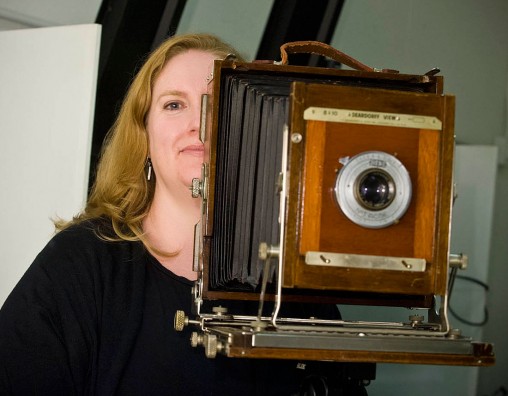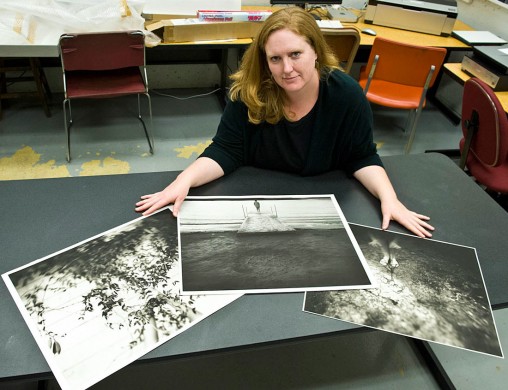
Historic photographic processes and study of the view camera are part of the curriculum in Wright State’s Department of Art and Art History’s photography program. Tracy Longley-Cook has been a driving force in the program.
It was the power of the photograph. Mesmerized by a famous Alfred Eisenstaedt photo of Adolf Hitler shaking hands with Italy’s Benito Mussolini in 1933, Tracy Longley-Cook began collecting memorable photos in high school.
“It was just a two-dimensional piece of paper. Why does it have so much impact?” she recalled asking herself. “I just had this pull toward images.”
That pull propelled Longley-Cook into a career in photography and teaching.
Today, she is an associate professor of art and art history at Wright State and a driving force behind the growth of the university’s photography program.
“We have a very strong photography program that has been getting better every year,” she said. “What we offer here is a very strong foundation of photography. The things you learn here can be applicable to any field that you want to go into.”
Born and raised in San Diego by her engineer parents, Longley-Cook’s introduction to the arts was slow. But when she finally discovered photography, something clicked.
After graduating high school in 1991, she moved to Seattle and began studying photography at Shoreline Community College, later transferring to the University of Washington.

Tracy Longley-Cook says she’s interested in exploring ideas through photography and the power of an image through visual metaphor.
She took a year off to attend the Maine Photographic Workshops in Rockport, Maine, where the small classes and intensive study of the history, craft and processes of photography changed the course of her life.
“That was when I really blossomed and found a voice in the work,” she said. “I became interested in exploring ideas through photography and exploring that power of the image through visual metaphor.”
After graduating from the University of Washington with a bachelor’s degree in fine arts, she took multiple jobs to pay the bills — working for a book artist, as a business manager for photographer Robert Lyons and at the aptly named Still Life Cafe in Seattle.
Then employment and educational opportunities had Longley-Cook hopscotching around the country. She worked at the Museum of Photographic Arts in San Diego, taught photography at the Waterford School in Sandy, Utah, obtained her master’s degree in fine arts from Arizona State University and took a teaching job at Florida State University.
In 2008, she joined the faculty at Wright State.
Photography at Wright State is a fine-arts program, as opposed to photojournalism or commercial or scientific photography.
Students learn the technical aspect of photography such as historic processes, studio lighting, wet darkroom developing, digital techniques and various camera formats. But there is also a heavy emphasis on the aesthetic aspect of photography and its use to create ideas and convey messages.
“We give you a lot of leeway for exploration,” said Longley-Cook, who did a workshop in Italy over the summer. “We’re here to promote creative thinking, to promote creative problem solving.”
Honeycombed in the basement of the Creative Arts Center is a darkroom, developing area and photo lab, where enlargers line up like soldiers.
Fanned out on a table in the photo lab this day are black-and-white photos of Longley-Cook’s work — a woman at the end of a pier, a woman holding a tree branch to the sky. And then there is an abstract photo difficult to identify.
That photo is her effort to push the medium of photography with as few tools as possible.
“I’ve been taking photographic chemistry, putting it on my skin, pushing it on film, developing that and having this one-of-a-kind stamp of parts of my body,” she said. “I don’t want it to be immediately recognizable. It’s something you should sort of come to.”
Longley-Cook said the camera is merely an extension of how a people see and record the world around them. The words “photo graphy” have Greek origins meaning “drawing with light.”
“There are people who are very good at just naturally composing things,” she said. “Those with an artistic and aesthetic eye see things in a way that is balanced and composed.”
Longley-Cook is holding on tight to teaching the skills of developing film in a wet darkroom in addition to digital, even though many college programs are going completely digital.
Digital photography uses electronic photodetectors to capture images focused by the lens, as opposed to an exposure on photographic film that is later developed in a wet darkroom. The captured image is then digitized and stored as a computer file ready for processing, viewing or printing.
“There are some things in the darkroom that still cannot be quite mimicked digitally,” said Longley-Cook. “The product is very, very different. Each process requires a different type of thinking.”
Longley-Cook said the Internet and social media have diluted the power of the photograph because people are bombarded with so many images.
“We cycle through images faster and faster without thinking about them, without spending time with them,” she said. “That’s probably one of the largest challenges I have with students — asking them to stop and look and critically think about a photo for 10 minutes. It’s like I asked them to do a week of silent meditation.”
The challenge, she said, is to teach students to make photos that have an arresting, stop-you-in-your-tracks effect on the viewers.
“How do you find your voice — your specific voice — as an imagemaker in that arena?” she said.
The photography program at Wright State has been growing. There are currently about 60 students in the program, with 15 students per class on average.
Graduates typically go into journalism or commercial fields such as wedding and portrait photography; or they go on to graduate school or teach. Last year, one of the program’s graduates, Heather Ballard, won first place and honorable mention in a competition sponsored by the Three Arts Scholarship Fund in Cincinnati, taking home $8,000 in prize money.
“I’ve never really had to sell our program,” Longley-Cook said.

 Wright State research draws attention to behavioral health’s economic impact
Wright State research draws attention to behavioral health’s economic impact  Alumni mentorship program helps new students feel welcome at Wright State
Alumni mentorship program helps new students feel welcome at Wright State  Educating future educators
Educating future educators  Student Success Center expands services to support Wright State students
Student Success Center expands services to support Wright State students  Wright State’s undergrad computer science and engineering programs ranked among top in Ohio by U.S. News
Wright State’s undergrad computer science and engineering programs ranked among top in Ohio by U.S. News 